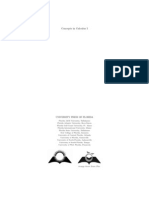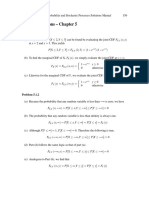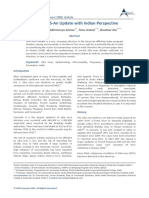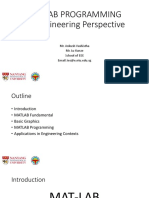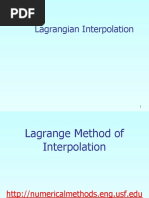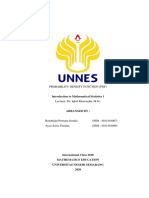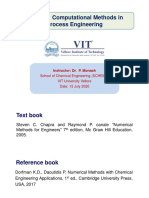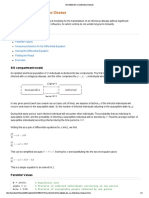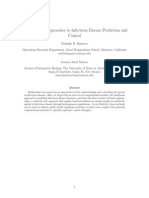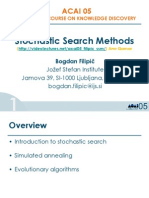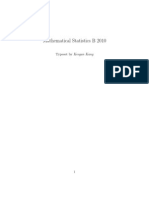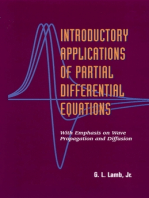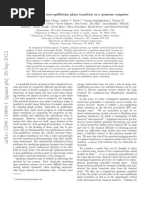Template For Parameter Estimation With Matlab Optimization Toolbox PDF
Uploaded by
achegesTemplate For Parameter Estimation With Matlab Optimization Toolbox PDF
Uploaded by
achegesNvR 1
TemplateforparameterestimationwithMatlabOptimizationToolbox;includingdynamic
systems
1.Curvefitting
Aweightedleastsquaresfitforamodelwhichislesscomplicatedthanthesystemthatgeneratedthe
data(acaseofsocalledundermodeling).
System:
3
2
0 1
( 1) 1 2
x
e x
y
x x
< <
=
< <
(1.1)
Data(noisemodel):
(0,0.05)
data
y y N = + (1.2)
withadditivezeromeanwhitenoiseZMWNwithastandarddeviationof0.05.
Modeltofitthedata:
( ) a x b
fit
y e
+
= (1.3)
withparameterstobefittedu=[a,b].
Themodelcanbeforcedtofitthesecondpartofthedata(1<x<2)byassigningdifferentweights
tothedata.Errorfunction:
( )
( )
( )
1
2
( , ) 0 1
( , )
( , ) 1 2
data fit
data fit
data fit
w y y x x
e w y y x
w y y x x
u
u
u
< <
= =
< <
(1.4)
withw
1
=1andw
2
=10.
ToimplementandsolvetheweightedleastsquaresfittingprobleminMatlabthefunction
LSQNONLINoftheOptimizationToolboxisused.Optimizationalgorithms(infactaminimizationis
performed)requiretheusertospecifyaninitialguessu
0
fortheparameters.Hereweuseu
0
=[0.1,1
].
TheMatlabcodeintheboxbelowcanbecopiedandpasteintheMatlabeditorandthensaved(or
pushtheRunbuttonwhichwillsaveandautomaticallyrunthecode).
f unct i on myFi t
%myFi t Wei ght ed l east squar es f i t
%%cr eat e t he f i r st hal f of t he dat a
xdat a1 = 0: . 01: 1;
ydat a1 = exp( - 3*xdat a1) + r andn( si ze( xdat a1) ) *. 05;
wei ght 1 = ones( si ze( xdat a1) ) *1;
%%cr eat e t he second hal f of t he dat a
%use a di f f er ent f unct i on and wi t h hi gher wei ght s
xdat a2 = 1: . 01: 2;
ydat a2 = ( xdat a2- 1) . ^2 + r andn( si ze( xdat a2) ) *. 05;
wei ght 2 = ones( si ze( xdat a2) ) *10;
NvR 2
%%combi ne t he t wo dat a set s
xdat a = [ xdat a1 xdat a2 ] ;
ydat a = [ ydat a1 ydat a2 ] ;
wei ght = [ wei ght 1 wei ght 2 ] ;
%%cal l | LSQNONLI N|
par amet er _hat = l sqnonl i n( @mycur ve, [ . 1 - 1] , [ ] , [ ] , [ ] , xdat a, ydat a)
%%pl ot t he or i gi nal dat a and f i t t ed f unct i on
pl ot ( xdat a, ydat a, ' b. ' )
hol d on
f i t t ed = exp( par amet er _hat ( 1) . *( par amet er _hat ( 2) +xdat a) ) ;
pl ot ( xdat a, f i t t ed, ' r ' )
xl abel ( ' x' ) ; yl abel ( ' y' )
l egend( ' Dat a' , ' Fi t ' )
%%f unct i on t hat r epor t s t he er r or
f unct i on er r = mycur ve( par amet er , r eal _x, r eal _y)
f i t = exp( par amet er ( 1) . *( r eal _x + par amet er ( 2) ) ) ;
er r = f i t - r eal _y;
%wei ght t he er r or accor di ng t o t he | WEI GHT| vect or
er r _wei ght ed = er r . *wei ght ;
er r = er r _wei ght ed;
end
end
ExecutingthisMatlabprogramresultsin:
par amet er _hat =
3. 1001 - 1. 9679
0 0.2 0.4 0.6 0.8 1 1.2 1.4 1.6 1.8 2
-0.2
0
0.2
0.4
0.6
0.8
1
1.2
x
y
Data
Fit
So
3.1001( 1.9679) x
fit
y e
=
NvR 3
However,herewedonotobtainanyinformationabouttheaccuracyoftheestimated
u .For
example,wedonotknowhowcriticalthefitdependsonalldigitsintheparametervaluesreturned
byMatlab.
2.Parameterestimationforadynamicmodel
Inthesecondexampleweconsideradynamicalsystem.Ifbloodplasmaandatissueororganof
interestcanbeconsideredasconnectedcompartmentsthenthefollowingmodelcanbeusedto
describetissueperfusion:
( )
trans
e
a e
e
dC K
C C
dt u
=
t e e
C C u =
inwhichthearterialplasmaconcentrationC
a
(t)istheinputandthetissueconcentrationC
t
(t)isthe
output.
Thislineardifferentialequationmodelcanbetransformedinto2descriptionsoftenusedinsystem
andcontrolengineering.
a)Statespaceformat:
( ) ( ) ( )
( ) ( ) ( )
x t Ax t Bu t
y t Cx t Du t
= +
= +
, ,
a e t
u C x C y C = = = ,
u u
= =
trans trans
e e
K K
A B , , 0 u = =
e
C D
b)Transferfunction:
( )
( )
( )
trans
t
trans
a e
C s K
H s
C s s K u
= =
+
TheControlToolboxfromMatlabcanbeusedtoimplementandsimulatethismodel.
Theparametersu=[K
trans
,u
e
]needtobeestimatedfromclinicaldata.Tissueperfusioncanbe
measuredwithDynamicContrastEnhancedMRI(DCEMRI).Acontrastagentisinjectedintothe
bloodstream,circulatesthroughthebodyanddiffusesintotissuesandorgans.Thekineticsof
contrastenhancementismeasuredinavoxelinthetissueofinterest,whichcanbetranslatedintoa
concentration.
Thefollowingnoise(error)modelisassumed/proposed:
t
y C = + (1.5)
withZMWNandthereforethesumofsquarederrorsisusedasestimator.
Inthiscasethepurposeofthemodelisnotjusttobeabletodescribethedata,butdifferencesinthe
estimatedparametervalueshaveabiologicalmeaningandmightbeusedforclinicaldiagnosisand
decisions.Henceitiscriticallyimportanttoassesstheaccuracyoftheestimates.Forthisproblemthe
estimatoristheMaximumLikelihoodEstimator(MLE)anditispossibletocalculatethecovariance
NvR 4
matrixoftheparameterestimates,whichquantifiestheaccuracyoftheestimate.(Theinverseofthe
covariancematrixisknownastheFisherInformationMatrix.)
InthesubsequentMatlabcodeitisshownhowthecovariancematrixcanbecalculatedfromthe
outputsprovidedbytheLSQNONLINfunction.Asinitialguessesu
0
=[2e3,0.1]willbeused.
f unct i on compar t ment
%compar t ment Est i mat i ng phar macoki net i c par amet er s usi ng a dynami c 2
%compar t ment model
%Loads dat af i l e pmpat 010. t xt .
%%Load dat a
dat af i l e = ' pmpat 010. t xt ' ;
dat a = l oad( dat af i l e) ;
t =dat a( 1, : ) ; %[ s]
Ca=dat a( 2, : ) ; %[ mM] ar t er i al i nput f unct i on
Ct =dat a( 3, : ) ; %[ mM] t i ssue r esponse
f i gur e; pl ot ( t , Ca, ' . b' , t , Ct , ' . r ' ) ; hol d on
xl abel ( ' Ti me [ s] ' ) ; yl abel ( ' [ mM] ' )
l egend( ' AI F' , ' Ct ' )
N=l engt h( Ct ) ;
%%Si mul at e model wi t h i ni t i al par amet er val ues
%Si mul at e
Kt r ans = 2e- 3; ve = 0. 1;
p = [ Kt r ans, ve] ;
[ y, t ] = compar t _l si m( t , Ca, p) ;
pl ot ( t , y, ' k' ) ;
%%Est i mat e par amet er s and var i ances
opt i m_opt i ons = opt i mset ( ' Di spl ay' , ' i t er ' , . . .
. . . %' Tol Fun' , 1e- 6, . . . %def aul t : 1e- 4
. . . %' Tol X' , 1e- 6, . . . %def aul t : 1e- 4
' Levenber gMar quar dt ' , ' on' ) ; %def aul t : ' of f '
%opt i m_opt i ons = [ ] ;
p0 = [ Kt r ans, ve] ;
[ p, r esnor m, r esi dual , exi t f l ag, OUTPUT, LAMBDA, J acobi an] =
l sqnonl i n( @compar t _er r or , p0, [ ] , [ ] , opt i m_opt i ons, t , Ca, Ct ) ;
di sp( ' ' )
p
%Est i mat ed par amet er var i ance
J acobi an = f ul l ( J acobi an) ; %l sqnonl i n r et ur ns t he J acobi an as a spar se
mat r i x
var p = r esnor m*i nv( J acobi an' *J acobi an) / N
st dp = sqr t ( di ag( var p) ) ; %st andar d devi at i on i s squar e r oot of var i ance
st dp = 100*st dp' . / p; %[ %]
di sp( [ ' Kt r ans: ' , num2st r ( p( 1) ) , ' +/ - ' , num2st r ( st dp( 1) ) , ' %' ] )
di sp( [ ' ve: ' , num2st r ( p( 2) ) , ' +/ - ' , num2st r ( st dp( 2) ) , ' %' ] ) ;
%%Si mul at e est i mat ed model
[ y, t ] = compar t _l si m( t , Ca, p) ;
f i gur e; subpl ot ( 211) ; pl ot ( t , Ct , ' . r ' , t , y, ' b' ) ;
xl abel ( ' Ti me [ s] ' ) ; yl abel ( ' [ mM] ' )
l egend( ' dat a' , ' model ' )
NvR 5
xi = Ct ( : ) - y( : ) ; %same as r esi dual f r oml sqnonl i n
subpl ot ( 212) ; pl ot ( t , xi )
xl abel ( ' Ti me [ s] ' ) ; l egend( ' r esi dual s \ xi ' )
assen=axi s;
%%f unct i on t o si mul at e compar t ment model
f unct i on [ y, t ] = compar t _l si m( t , Ca, p)
Kt r ans = p( 1) ; ve = p( 2) ;
num= [ Kt r ans*ve] ;
den = [ ve, Kt r ans] ;
sys = t f ( num, den) ;
[ y, t ] = l si m( sys, Ca, t ) ;
end
%%f unct i on t o cal cul at e MLE er r or
f unct i on xi = compar t _er r or ( p, t , Ca, Ct )
[ y, t ] = compar t _l si m( t , Ca, p) ;
xi = Ct ( : ) - y( : ) ; %make sur e bot h vect or s ar e col umns
%f i gur e( 1) ; pl ot ( t , Ct , ' . ' , t , y, ' g' ) ; hol d of f ; dr awnow %uncomment t hi s l i ne
t o show
%dat af i r f or each opt i mi zat i on i t er at i on ( sl ows down t he execut i on)
end
end %mai n f unct i on
Whentheprogramisexecuted,firstafigureisreturnedwiththeinputdata(concentrationinblood
plasma,AIF,inblue),theoutputdata(tissuecompartment,Ct,inred)andthemodelsimulation
giventheinitialparametervaluesu
0
(solidblackline).
0 100 200 300 400 500 600
-5
0
5
10
15
20
25
30
35
Time [s]
[
m
M
]
AIF
Ct
Secondlytheresultsoftheparameterestimation(vectorofestimatedparameters,estimated
parametercovariancematrix,andtheparameterestimateswiththeirrelativestandarddeviation,in
(%)):
p =
NvR 6
0. 0097 0. 2018
var p =
1. 0e- 005 *
0. 0133 - 0. 0025
- 0. 0025 0. 2574
Kt r ans: 0. 0096992 +/ - 3. 764%
ve: 0. 20176 +/ - 0. 79515%
Finally,afigurewithaplotoftheidentifiedmodelandthedata(toppanel),andaplotofthe
differencebetweenmodelanddata(residuals,bottom).
0 100 200 300 400 500 600
-2
0
2
4
Time [s]
[
m
M
]
data
model
0 100 200 300 400 500 600
-1
-0.5
0
0.5
1
Time [s]
residuals
NvR 7
3.Template
Finallyatemplateisprovidedtoestimateasubsetoftheparametersinamodel(someparameters
areassumedtobeknownandthereforearefixed)andthemodeliscomposedofasetofcoupled
firstordernonlineardifferentialequations(simulatedwithoneoftheMatlabodesolvers).
Templ at e f or Nonl i near Least Squar es est i mat i on and Fi sher I nf or mat i on
Mat r i x
%%Load dat a
%f or exampl e f r omExcel
dat a = xl sr ead( . . .
%obt ai n / def i ne exper i ment al t i me vect or
t exp =
%%Si mul at i on t i me and i nput
t si m= t exp; %not necessar i l y t he same
%I nput mat r i x ( 1st col umn t i me ( can be di f f er ent f r omexper i ment al t i me) ,
2nd col umn, et c. cor r espondi ng i nput val ues
t u = [ t exp, u1, u2, . . .
%%Par amet er s and i ni t i al condi t i ons of st at e var i abl es
k1 = . . .
%assi gn par amet er s t o vect or wi t h known ( f i xed) par amet er s and a vect or of
par amet er s t o be est i mat ed
pest = [ . . .
pf i x = [ . . .
%t ot al par amet er vect or : p = [ pf i x pest ]
%t he same f or t he i ni t i al condi t i ons
x0est = [ . . .
x0f i x = [ . . .
%t ot al i ni t i al condi t i ons: x0 = [ x0f i x x0est ]
%t ot al vect or of quant i t i es t o be est i mat ed:
px0est =[ pest x0est ]
%%Opt i mi zat i on al gor i t hm
%Set t i ngs l sqnonl i n
l b = zer os( si ze( px0est ) ) ;
ub = [ ] ;
opt i ons = opt i mset ( ' Tol Fun' , 1e- 4, . . . %def aul t : 1e- 4
' Tol X' , 1e- 5, . . . %def aul t : 1e- 4
' Levenber gMar quar dt ' , ' on' , . . . %def aul t : on
' Lar geScal e' , ' on' ) ; %def aul t : on
%LSQNONLI N: obj ect i ve f unct i on shoul d r et ur n t he model er r or vect or
[ px0est , r esnor m, RESI DUAL, EXI TFLAG, OUTPUT, LAMBDA, J acobi an] =
l sqnonl i n( @obj f nc, px0est , l b, ub, opt i ons, . . .
t exp, dat a, t u, pf i x, x0f i x) ;
%%( est i mat ed) Pr eci si on:
J acobi an = f ul l ( J acobi an) ; %l sqnonl i n r et ur ns t he j acobi an as a spar se
mat r i x
%Par amet er covar i ance mat r i x ( i nver se of Fi sher I nf or mat i on Mat r i x)
var p = r esnor m*i nv( J acobi an' *J acobi an) / l engt h( t exp) ;
%St andar d devi at i on i s t he squar e r oot of t he var i ance
st dp = sqr t ( di ag( var p) ) ;
NvR 8
%%Reconst r uct par amet er and i ni t i al condi t i on vect or s
pest = px0est ( . : . )
p = [ pf i x pest ] ;
x0est = px0est ( . : . )
x0 = [ x0f i x x0est ] ;
%%Si mul at i on wi t h est i mat ed par amet er s
ode_opt i ons = [ ] ;
[ t , x] = ode15s( @odef nc, t si m, x0, ode_opt i ons, t u, p) ;
- -
%Obj ect i ve / cost f unct i on f or l east squar es
f unct i on e = obj f nc( px0est , t exp, dat a, t u, pf i x, x0f i x)
%e: vect or of model r esi dual s
%Reconst r uct par amet er and i ni t i al condi t i on vect or s
pest = px0est ( . : . )
p = [ pf i x pest ] ;
x0est = px0est ( . : . )
x0 = [ x0f i x x0est ] ;
%%Si mul at i on
ode_opt i ons = [ ] ;
[ t , x] = ode15s( @odef nc, t exp, x0, ode_opt i ons, t u, p) ;
%Model out put ( s)
y = x( : , 1) ;
%%Model r esi dual s
e = dat a- y;
- -
%Model i n st at e- space f or mat ( syst emof coupl ed 1st or der ODE' s)
f unct i on dx = odef nc( t , x, t u, p)
%t : cur r ent t i me
%x : st at e val ues at t i me t
%t u: mat r i x wi t h t i me poi nt s ( 1st col umn) and cor r espondi ng i nput si gnal
val ue ( 2nd col umn)
%p : par amet er s
%dx: new st at e der i vat i ves ( col umn vect or )
%cal cul at e i nput u( k) by i nt er pol at i on of t u
u = i nt er p1( t u( : , 1) , t u( : , 2) , t ) ;
%ode' s
dx1 = . . .
%col l ect der i vat i ves i n col umn vect or
dx = [ dx1; dx2 . . . ] ;
You might also like
- Basic Numerical Method Using Scilab-ID2069No ratings yetBasic Numerical Method Using Scilab-ID20698 pages
- MATHEMATICS Parallel Scientific ComputationNo ratings yetMATHEMATICS Parallel Scientific Computation324 pages
- Global Stability For SIR and SIRS Models With Svfkjnsfvdifferential Mortality BecharaNo ratings yetGlobal Stability For SIR and SIRS Models With Svfkjnsfvdifferential Mortality Bechara14 pages
- Parameter Searching For Epidemiology Models Using Bayesian OptimizationNo ratings yetParameter Searching For Epidemiology Models Using Bayesian Optimization14 pages
- SIR Models: An Introduction: Tingda Wang July 2020No ratings yetSIR Models: An Introduction: Tingda Wang July 202019 pages
- Introduction To MATLAB: Engineering Software Lab C S Kumar ME DepartmentNo ratings yetIntroduction To MATLAB: Engineering Software Lab C S Kumar ME Department36 pages
- Estimation Theory: x, x, x ,…… ……x ,x f x,θ θ θ θNo ratings yetEstimation Theory: x, x, x ,…… ……x ,x f x,θ θ θ θ18 pages
- App.A - Detection and Estimation in Additive Gaussian Noise PDFNo ratings yetApp.A - Detection and Estimation in Additive Gaussian Noise PDF55 pages
- DynamicalSystemsWithApplicationsUsingPython 2ed Lynch PDF100% (2)DynamicalSystemsWithApplicationsUsingPython 2ed Lynch PDF104 pages
- An Introduction To Bayesian Statistics and MCMC MethodsNo ratings yetAn Introduction To Bayesian Statistics and MCMC Methods69 pages
- Comparative Analysis of Different Numerical Methods For The Solution of Initial Value Problems in First Order Ordinary Differential Equations100% (1)Comparative Analysis of Different Numerical Methods For The Solution of Initial Value Problems in First Order Ordinary Differential Equations3 pages
- ZIKA VIRUS-An Update With Indian PerspectiveNo ratings yetZIKA VIRUS-An Update With Indian Perspective5 pages
- MATLAB PROGRAMMING An Engineering PerspectiveNo ratings yetMATLAB PROGRAMMING An Engineering Perspective129 pages
- 202004160626023624rajiv Saksena Advance Statistical InferenceNo ratings yet202004160626023624rajiv Saksena Advance Statistical Inference31 pages
- Mathematical Model For Malaria TransmissionNo ratings yetMathematical Model For Malaria Transmission32 pages
- Introduction of Frechet and Gateaux DerivativeNo ratings yetIntroduction of Frechet and Gateaux Derivative6 pages
- Ugc Model Curriculum Statistics: Submitted To The University Grants Commission in April 2001No ratings yetUgc Model Curriculum Statistics: Submitted To The University Grants Commission in April 2001101 pages
- A Factorisation Algorithm in Adiabatic Q PDFNo ratings yetA Factorisation Algorithm in Adiabatic Q PDF11 pages
- Dimitrov InfectiousDiseaseModelTutorialNo ratings yetDimitrov InfectiousDiseaseModelTutorial30 pages
- An Introduction To Stochastic Epidemic Models-Part INo ratings yetAn Introduction To Stochastic Epidemic Models-Part I53 pages
- Ma6351-Transforms and Partial Differential Equations Anna University Important QuestionsNo ratings yetMa6351-Transforms and Partial Differential Equations Anna University Important Questions14 pages
- Arthur E. Albert, Leland A. Gardner Jr. Stochastic Approximation and NonLinear RegressionNo ratings yetArthur E. Albert, Leland A. Gardner Jr. Stochastic Approximation and NonLinear Regression211 pages
- Introductory Applications of Partial Differential Equations: With Emphasis on Wave Propagation and DiffusionFrom EverandIntroductory Applications of Partial Differential Equations: With Emphasis on Wave Propagation and DiffusionNo ratings yet
- Simple Oscillator (Oscillator) : Yddot Ydot y 1 S 1 S ScopeNo ratings yetSimple Oscillator (Oscillator) : Yddot Ydot y 1 S 1 S Scope15 pages
- CSCE 221 Cover Page Programming Assignment #3No ratings yetCSCE 221 Cover Page Programming Assignment #33 pages
- A Comprehensive Review of Supervised and Unsupervised Machine Learning TechniquesNo ratings yetA Comprehensive Review of Supervised and Unsupervised Machine Learning Techniques3 pages
- 11 Solving Linear IVPs by Laplace TransformsNo ratings yet11 Solving Linear IVPs by Laplace Transforms14 pages
- A Mobile Robot Path Planning Using Genetic Algorithm in Static EnvironmentNo ratings yetA Mobile Robot Path Planning Using Genetic Algorithm in Static Environment4 pages
- Download ebooks file Weak interactions and modern particle theory Howard Georgi all chapters100% (2)Download ebooks file Weak interactions and modern particle theory Howard Georgi all chapters80 pages
- Shallow and Deep Artificial Neural Networks For Structural Reliability AnalysisNo ratings yetShallow and Deep Artificial Neural Networks For Structural Reliability Analysis8 pages
- Devsu Code Jam 2021 - Preliminary PhaseNo ratings yetDevsu Code Jam 2021 - Preliminary Phase15 pages
- Characterizing A Non-Equilibrium Phase Transition On A Quantum ComputerNo ratings yetCharacterizing A Non-Equilibrium Phase Transition On A Quantum Computer25 pages
- Unit 6: Stability of Linear Control SystemNo ratings yetUnit 6: Stability of Linear Control System14 pages
- (Bemf Mras) : Abstract - Model Reference Adaptive System (MRAS)No ratings yet(Bemf Mras) : Abstract - Model Reference Adaptive System (MRAS)1 page
- Multirate Digital Filters, Filter Banks, Polyphase Networks, Applications: TutorialNo ratings yetMultirate Digital Filters, Filter Banks, Polyphase Networks, Applications: Tutorial38 pages
- Natural Response Neither Grows Nor Approaches Zero As Time (ForNo ratings yetNatural Response Neither Grows Nor Approaches Zero As Time (For9 pages
- Multivariate Convex Regression With Adaptive PartitioningNo ratings yetMultivariate Convex Regression With Adaptive Partitioning34 pages
- Machine_Learning_Approaches_to_Predict_Asthma_ExacNo ratings yetMachine_Learning_Approaches_to_Predict_Asthma_Exac19 pages
- Non Spherical Disturbances - Heteroskedasticity 1No ratings yetNon Spherical Disturbances - Heteroskedasticity 112 pages
- Global Stability For SIR and SIRS Models With Svfkjnsfvdifferential Mortality BecharaGlobal Stability For SIR and SIRS Models With Svfkjnsfvdifferential Mortality Bechara
- Parameter Searching For Epidemiology Models Using Bayesian OptimizationParameter Searching For Epidemiology Models Using Bayesian Optimization
- SIR Models: An Introduction: Tingda Wang July 2020SIR Models: An Introduction: Tingda Wang July 2020
- Introduction To MATLAB: Engineering Software Lab C S Kumar ME DepartmentIntroduction To MATLAB: Engineering Software Lab C S Kumar ME Department
- App.A - Detection and Estimation in Additive Gaussian Noise PDFApp.A - Detection and Estimation in Additive Gaussian Noise PDF
- DynamicalSystemsWithApplicationsUsingPython 2ed Lynch PDFDynamicalSystemsWithApplicationsUsingPython 2ed Lynch PDF
- An Introduction To Bayesian Statistics and MCMC MethodsAn Introduction To Bayesian Statistics and MCMC Methods
- Comparative Analysis of Different Numerical Methods For The Solution of Initial Value Problems in First Order Ordinary Differential EquationsComparative Analysis of Different Numerical Methods For The Solution of Initial Value Problems in First Order Ordinary Differential Equations
- 202004160626023624rajiv Saksena Advance Statistical Inference202004160626023624rajiv Saksena Advance Statistical Inference
- Ugc Model Curriculum Statistics: Submitted To The University Grants Commission in April 2001Ugc Model Curriculum Statistics: Submitted To The University Grants Commission in April 2001
- An Introduction To Stochastic Epidemic Models-Part IAn Introduction To Stochastic Epidemic Models-Part I
- Ma6351-Transforms and Partial Differential Equations Anna University Important QuestionsMa6351-Transforms and Partial Differential Equations Anna University Important Questions
- Arthur E. Albert, Leland A. Gardner Jr. Stochastic Approximation and NonLinear RegressionArthur E. Albert, Leland A. Gardner Jr. Stochastic Approximation and NonLinear Regression
- Introductory Applications of Partial Differential Equations: With Emphasis on Wave Propagation and DiffusionFrom EverandIntroductory Applications of Partial Differential Equations: With Emphasis on Wave Propagation and Diffusion
- Simple Oscillator (Oscillator) : Yddot Ydot y 1 S 1 S ScopeSimple Oscillator (Oscillator) : Yddot Ydot y 1 S 1 S Scope
- A Comprehensive Review of Supervised and Unsupervised Machine Learning TechniquesA Comprehensive Review of Supervised and Unsupervised Machine Learning Techniques
- A Mobile Robot Path Planning Using Genetic Algorithm in Static EnvironmentA Mobile Robot Path Planning Using Genetic Algorithm in Static Environment
- Download ebooks file Weak interactions and modern particle theory Howard Georgi all chaptersDownload ebooks file Weak interactions and modern particle theory Howard Georgi all chapters
- Shallow and Deep Artificial Neural Networks For Structural Reliability AnalysisShallow and Deep Artificial Neural Networks For Structural Reliability Analysis
- Characterizing A Non-Equilibrium Phase Transition On A Quantum ComputerCharacterizing A Non-Equilibrium Phase Transition On A Quantum Computer
- (Bemf Mras) : Abstract - Model Reference Adaptive System (MRAS)(Bemf Mras) : Abstract - Model Reference Adaptive System (MRAS)
- Multirate Digital Filters, Filter Banks, Polyphase Networks, Applications: TutorialMultirate Digital Filters, Filter Banks, Polyphase Networks, Applications: Tutorial
- Natural Response Neither Grows Nor Approaches Zero As Time (ForNatural Response Neither Grows Nor Approaches Zero As Time (For
- Multivariate Convex Regression With Adaptive PartitioningMultivariate Convex Regression With Adaptive Partitioning
- Machine_Learning_Approaches_to_Predict_Asthma_ExacMachine_Learning_Approaches_to_Predict_Asthma_Exac

























